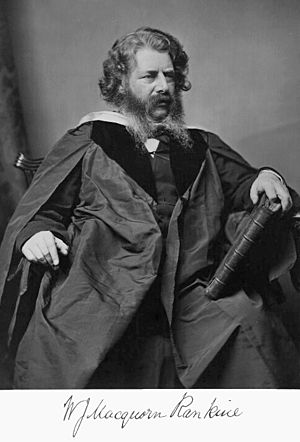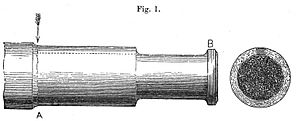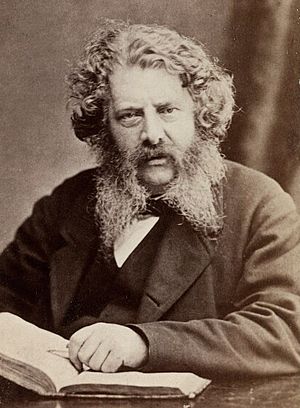William Rankine facts for kids
Quick facts for kids
William John Macquorn Rankine
FRSE FRS
|
|
|---|---|

William John Macquorn Rankine
|
|
| Born | 5 July 1820 Edinburgh, Scotland
|
| Died | 24 December 1872 (aged 52) Glasgow, Scotland
|
| Nationality | Scottish |
| Alma mater | University of Edinburgh |
| Known for |
|
| Awards | Keith Medal (1854) |
| Scientific career | |
| Fields | Physics, engineering, civil engineering |
| Institutions | University of Glasgow |
| Influenced | Pierre Duhem |
William John Macquorn Rankine (born July 5, 1820 – died December 24, 1872) was a brilliant Scottish engineer and scientist. He made big contributions to mechanical engineering, civil engineering, physics, and mathematics.
Rankine was one of the first people, along with Rudolf Clausius and William Thomson (Lord Kelvin), to help create the science of thermodynamics. This field studies how heat and other forms of energy work. He was especially interested in the First Law of Thermodynamics. He also created the Rankine scale, which is a temperature scale similar to the Kelvin scale, but it uses Fahrenheit degrees instead of Celsius.
He developed a full theory for how steam engines and other heat engines work. His engineering textbooks were used for many years. Rankine wrote hundreds of papers on science and engineering. His interests were very wide, from botany and music theory when he was young, to most major areas of science and engineering later in life. He was also a talented amateur singer, pianist, and cellist who wrote his own funny songs.
Contents
Life and Education
William Rankine was born in Edinburgh, Scotland. His father, David Rankin, was a civil engineer. His mother was Barbara Grahame. The family moved often because of his father's work on different projects.
William first learned at home. Later, he went to Ayr Academy and the High School of Glasgow. In 1834, he studied at the Scottish Naval and Military Academy. By then, he was already very good at mathematics. He even received a copy of Isaac Newton's famous book Principia as a gift.
University Studies and Early Career
In 1836, Rankine started studying science at the University of Edinburgh. He studied natural history and natural philosophy (which is what physics was called back then). He won awards for his essays on how to do scientific research and on the wave theory of light.
During his school breaks, he helped his father, who managed the Edinburgh and Dalkeith Railway. This railway brought coal into the city. Rankine left the university in 1838 without a degree, which was common then. He became an apprentice to Sir John Benjamin Macneill, a railway surveyor in Ireland.
While working there, Rankine developed a new way to lay out railway curves. This method, called Rankine's method, used a tool called a theodolite to make the curves much more accurate. In 1842, he tried to describe heat using mathematics, but he needed more experimental information. That same year, he organized a huge bonfire on Arthur's Seat in Edinburgh to celebrate Queen Victoria's visit.
In 1850, Rankine became a member of the Royal Society of Edinburgh. He won the Society's Keith Prize a few years later. From 1855 until his death, he was a professor at Glasgow University. He taught civil engineering and mechanics.
William Rankine passed away on Christmas Eve, December 24, 1872, in Glasgow. He was 52 years old. He was not married and had no children.
Contributions to Thermodynamics
Rankine was very interested in how heat engines work. In 1849, he figured out the connection between how much steam pressure there is and its temperature. The next year, he used his ideas to find relationships between the temperature, pressure, and density of gases. He also found ways to calculate the latent heat needed to turn a liquid into a gas. He even correctly predicted that the specific heat of saturated steam would be negative, which was a surprising discovery.
Efficiency of Heat Engines
In 1851, Rankine calculated how efficient heat engines could be. He showed that the best possible efficiency for any heat engine depends only on the two temperatures it works between. Other scientists like Rudolf Clausius and William Thomson had found similar results. But Rankine said his findings came from his own ideas about tiny particles. In 1853, he also came up with the term "potential energy".
Rankine later explained his ideas using bigger concepts of energy and how it changes. He defined "actual energy" (energy that is used up) and "potential energy" (stored energy). He believed that the total of these two energies stayed the same. This idea is now known as the conservation of energy.
From 1854, he used his "thermodynamic function," which was later found to be the same as entropy (a measure of disorder). By 1855, Rankine had created a "science of energetics." This explained how things move and change using energy, instead of just force and motion. This was the first time energy was defined as the ability to do work, which is now the standard definition.
Rankine Scale and Heat Death Paradox
In 1859, Rankine suggested the Rankine scale of temperature. This is an absolute temperature scale where each degree is equal to a Fahrenheit degree. In 1862, he worked with Lord Kelvin to develop the heat death paradox. This idea suggests that if the universe were infinitely old, all energy would have spread out evenly, and nothing would be able to happen. This paradox helped show that the universe likely had a beginning.
Rankine used his theories to create many practical results for engineers, including:
- The Rankine–Hugoniot equation: This equation helps understand how shock waves behave.
- The Rankine cycle: This is a model for how an ideal heat engine with a condenser works. It helps engineers design efficient power plants.
- Understanding the properties of steam, gases, and other vapors.
Fatigue Studies in Materials
Rankine was one of the first engineers to realize that railway axles broke because of "fatigue". This means tiny cracks started and grew in the metal over time due to repeated stress. In the 1840s, he looked at many broken axles, especially after the Versailles train crash in 1842. In this accident, a locomotive axle broke suddenly, causing over 50 deaths.
He showed that the axles failed because a brittle crack slowly grew from a weak spot, like a sharp corner or a keyway. Other engineers, like Joseph Glynn, also found similar results. This process is now called metal fatigue.
Rankine shared his findings with the Institution of Civil Engineers. However, many engineers at the time did not believe him. They thought that stress caused the metal to "re-crystallize," which was incorrect. This misunderstanding slowed down research into metal fatigue. Even though it was a serious problem causing many accidents, it wasn't fully understood until later. Today, we know much more about fatigue, which helps engineers design safer structures and machines.
Other Important Work
Rankine was a professor at the University of Glasgow from 1855 until his death. He did a lot of research in both civil and mechanical engineering.
He also helped start the Glasgow and Strathclyde Universities Officer Training Corps in 1859. He became a Major in 1860 and served until 1864.
Civil Engineering Contributions
The Rankine Lectures, held by the British Geotechnical Association, are named after him. This is because of his important work in:
- Understanding forces in frame structures, like bridges.
- Soil mechanics, especially how to calculate lateral earth pressure theory and how to make retaining walls stable. The Rankine method for earth pressure analysis is named after him.
Rankine worked closely with shipbuilders in Clyde, Scotland, especially his friend James Robert Napier. Together, they helped turn naval architecture (the science of designing ships) into a proper engineering field. He helped found the Institution of Engineers & Shipbuilders in Scotland in 1857 and was its first President. He was also an early member of the Royal Institution of Naval Architects. Rankine was part of the team that investigated the sinking of HMS Captain.
Awards and Honors
- Fellow of the Royal Scottish Society of Arts
- Associate of the Institution of Civil Engineers, 1843
- Fellow of the Royal Society of Edinburgh, 1850
- Fellow of the Royal Society of London, 1853
- Keith Medal of the Royal Society of Edinburgh, 1854
- Founding President of the Institution of Engineers and Shipbuilders in Scotland, 1857
- Received an honorary degree (LL.D.) from Trinity College Dublin, 1857
- Foreign member of the Royal Swedish Academy of Sciences, 1868
- The Rankine scale of temperature is named in his honor.
- Rankine, a small impact crater on the Moon, is also named after him.
- In 2013, he was one of four people added to the Scottish Engineering Hall of Fame.
See also
 In Spanish: William John Macquorn Rankine para niños
In Spanish: William John Macquorn Rankine para niños
- Momentum theory
- State function
- Track transition curve
Images for kids




